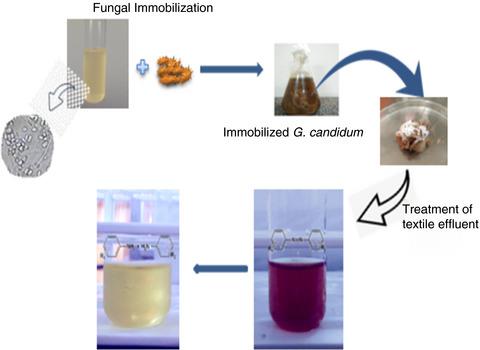当前位置:
X-MOL 学术
›
Lett. Appl. Microbiol.
›
论文详情
Our official English website, www.x-mol.net, welcomes your
feedback! (Note: you will need to create a separate account there.)
De‐colorization of textile effluent using immobilized Geotrichum candidum : An insight into mycoremediation
Letters in Applied Microbiology ( IF 2.0 ) Pub Date : 2020-12-21 , DOI: 10.1111/lam.13430 G. Rajhans 1 , S.K. Sen 2 , A. Barik 1 , S. Raut 1
Letters in Applied Microbiology ( IF 2.0 ) Pub Date : 2020-12-21 , DOI: 10.1111/lam.13430 G. Rajhans 1 , S.K. Sen 2 , A. Barik 1 , S. Raut 1
Affiliation

|
Textile effluent is generally complicated to manage because of its extremely noxious and recalcitrant colored compositions. Mycoremediation is an extensively used strategy for the competent degradation of hazardous pollutants present in textile effluent. Fungus could be immobilized in synthetic or natural matrices. The current study shows the decolorization of the textile effluent by 85.5% and 98.5% within 6h using suspended and immobilized fungus, Geotrichum candidum respectively with optimized parameters like inoculum size (5%), pH (4.5), and temperature (30˚C). To maintain a high biomass of fungal population and enhance the retention of fungal strain in the contaminated sites, the fungi need to be immobilized. Hence, the fungus was immobilized naturally onto the selected inert support i.e., coconut fibers by the means of adsorption, where they grew as active films on the fibers after being grown in the culture broth. The optimized process parameters of inoculum size, fiber quantity and agitation speed for immobilized G. candidum were 5%, 2.2 g l-1 of effluent and 100rpm, respectively. High level of laccase (22 U l-1 and 25 U l-1 during suspended and immobilized fungal cells treatment, respectively) was observed during the process of decolorization and it was found that decolorization was directly proportional to the laccase activity. The UV-vis, FTIR, 1 H NMR and GC-MS analyses of treated textile industrial wastewater revealed the degradation of toxic pollutants in the textile effluent and formation of lower molecular weight intermediates. The study revealed a higher efficacy of immobilized G. candidum in comparison to suspended fungal culture, employing ligninolytic enzyme laccase, which catalyzes the degradation/transformation of aromatic dyes in the textile effluent and thus decolorizing it.
中文翻译:

使用固定化白地霉对纺织废水进行脱色:对真菌介导的深入了解
纺织废水通常处理起来很复杂,因为它含有极其有害和顽固的有色成分。Mycoremediation 是一种广泛使用的策略,用于有效降解纺织废水中存在的有害污染物。真菌可以固定在合成或天然基质中。目前的研究表明,使用悬浮和固定真菌白地霉在 6 小时内对纺织废水的脱色率分别为 85.5% 和 98.5%,并优化了接种量 (5%)、pH (4.5) 和温度 (30˚C) 等参数. 为了保持真菌种群的高生物量并增强真菌菌株在受污染地点的保留,需要固定真菌。因此,真菌通过吸附的方式自然地固定在选定的惰性载体上,即椰子纤维上,在培养液中生长后,它们在纤维上以活性薄膜的形式生长。固定化白花酵母的接种量、纤维量和搅拌速度的优化工艺参数分别为5%、2.2 g l-1 和100rpm。在脱色过程中观察到高水平的漆酶(分别在悬浮和固定真菌细胞处理期间为22 U l-1 和25 U l-1),并且发现脱色与漆酶活性成正比。对处理过的纺织工业废水的 UV-vis、FTIR、1 H NMR 和 GC-MS 分析揭示了纺织废水中有毒污染物的降解和低分子量中间体的形成。该研究表明,与悬浮真菌培养相比,固定化白花酵母具有更高的功效,
更新日期:2020-12-21
中文翻译:

使用固定化白地霉对纺织废水进行脱色:对真菌介导的深入了解
纺织废水通常处理起来很复杂,因为它含有极其有害和顽固的有色成分。Mycoremediation 是一种广泛使用的策略,用于有效降解纺织废水中存在的有害污染物。真菌可以固定在合成或天然基质中。目前的研究表明,使用悬浮和固定真菌白地霉在 6 小时内对纺织废水的脱色率分别为 85.5% 和 98.5%,并优化了接种量 (5%)、pH (4.5) 和温度 (30˚C) 等参数. 为了保持真菌种群的高生物量并增强真菌菌株在受污染地点的保留,需要固定真菌。因此,真菌通过吸附的方式自然地固定在选定的惰性载体上,即椰子纤维上,在培养液中生长后,它们在纤维上以活性薄膜的形式生长。固定化白花酵母的接种量、纤维量和搅拌速度的优化工艺参数分别为5%、2.2 g l-1 和100rpm。在脱色过程中观察到高水平的漆酶(分别在悬浮和固定真菌细胞处理期间为22 U l-1 和25 U l-1),并且发现脱色与漆酶活性成正比。对处理过的纺织工业废水的 UV-vis、FTIR、1 H NMR 和 GC-MS 分析揭示了纺织废水中有毒污染物的降解和低分子量中间体的形成。该研究表明,与悬浮真菌培养相比,固定化白花酵母具有更高的功效,











































 京公网安备 11010802027423号
京公网安备 11010802027423号